|
|
I. Stereo assessment device – Carl Zeiss Jena - 1939
This amazing instrument is in our collection. It is marked with Carl Zeiss Jena; production number 75992, and two letters “SA”. The letters “SA” indicated that the device was used by Finish Army.
Making an examination of the item, at the first assessment, it was difficult to find out the aim of the device.
Complete stereo device; Copyrights picture Anna Vacani
The instrument consists of two parts.
The stereo device imparted; Copyrights picture Anna Vacani
The top part is as two cylindrical tubes with eye width adjustment incorporated.
The top part; Copyrights picture Anna Vacani
The base is very interesting. Looking into the lenses is visible a picture of an airplane and a scale.
The base of the device; Copyrights picture Anna Vacani
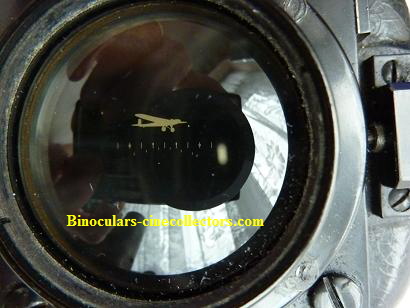
The picture of the airplane in the lens; Copyrights picture Anna Vacani
After the base was opened, inside were visible fitted two concave mirrors.
The device imparted, including the base; Copyrights picture Anna Vacani
The mirrors reflect the external light on to the target reticules.
Afterwards completion examination of all parts, the device was assembled. After adjustment the eye width and the sharpness of the pictures, moving up or down the cylindrical tubes, the pictures of the airplanes and scales are clearly visibly.
Copyrights picture Anna Vacani
Copyrights picture Anna Vacani
The device is with the original box marked with letters “SA” as it is on the device.
All elements of the box indicate that it was produced before the war; chromium metal parts, polished wood panted with varnished.
Never more during the war were produced these quality containers.
The weight of the device is approximately 2.0 kg.
We have found out a description in the Zeiss catalogue from May 1939.
The description has been kindly translated and transmitted to us by Burhardt Lorenz, the purpose of construction of the instrument turned out amazing.
It is pointed:
“Stereo assessment device:
Special Provision: The test instrument is used to examine the ability of stereoscopic measurement in general and to select capable staff for using distance control measurement devices in particular. In addition, it can also be used for educational purpose: to familiarize trainees with the stereoscopic measurement method. Used as a training device, measurements are possible at any time and without much effort to test out trainee mistakes or progress towards exact operation.
In the Zeiss catalogue we can read more about construction and learn to operate properly.
Construction: Looking into both eyepieces will show two pictures of a ship or an aircraft and two visible measuring mark images that will merge into stereo image if exact stereoscopic operation takes place. Adjusting a measuring screw will yield an apparent stereoscopic move of the measuring mark image towards the target image which will have the same optic impression as measuring with a stereo-telemeter device.
If the trainee did yield an apparent spatial agreement between the measuring mark image and the target image after adjusting the measuring screw, such as a real measurement with a telemeter, than a potential measuring error will show up in the accordant number of minimum errors at the reading cylinder immediately.
Minimum error is the one that is given to the limitation of the resolving power the human eye and that corresponds to an incorrect parallax angle (angle of intersection of the lines of sight to the target) of 10".
Before measuring, it is necessary to adjust the eyepieces to the visual acuity and eye distance of the trainee.
The test instrument can also be used in the dark, with then target images and measuring mark images illuminated with a lamp through a light window.
Container: During times of disuse, storage of the test instrument in a wood box.
In the “Construction” parts are mentioned two kinds of the pictures: an aircraft or a ship. Presumable the aim of the device was educated the specialist for the distance control from the earth or on the sea.
This education device let us imagine how much attention was paid for precise training of German soldiers, before the war.
We heard that the stereo assessment device was equipped with an instruction. We do not have the instruction.
If any collector of that device has the instruction, it will be nice to add it to this description and to develop the information about this unusual instrument.
II. Stereo assessment device – produced in Japan
This kind of education device was produced in Japan during WWII, as well, by the optical Company - Nippon Kogaku KK.
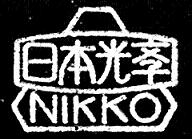 Nippon Kogaku KK logo; Dr Stephen Rohan - “A Guide to Handheld Military Binoculars 1894-1945”; page 163 Nippon Kogaku KK logo; Dr Stephen Rohan - “A Guide to Handheld Military Binoculars 1894-1945”; page 163
Picture from “Machinery Japan Optical and Precision Instruments” Publisher: Japan Optical & Precision Instruments Manufacturers’ Association; catalogue in our collection
The pictures of Japanese stereo assessment device, we have received from the collector Stephen Grose from Australia. As in our article “U-Boat binoculars” chapter III; page 5 we are mentioned that “In 1936 Germany signed treaties with Japan and Italy. In 1940 was singed The Tripartite Pact between Germany, Japan and Italy. Germany was in an economical cooperation with Japan as well, they exchange raw materials. Japan was receiving from Germany optical glass, among other items. ”
Presumable among them was the stereo assessment device as well. We can draw this conclusion studying closely photographs of the Japanese instrument.
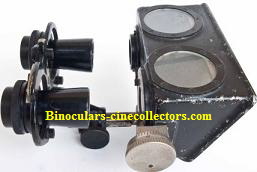 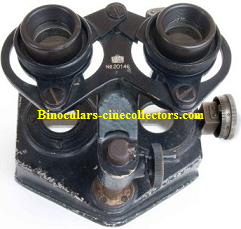 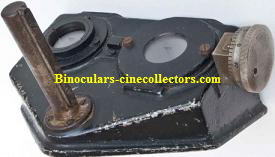
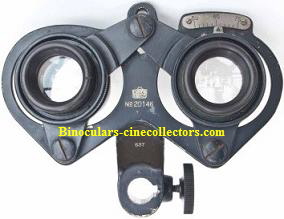 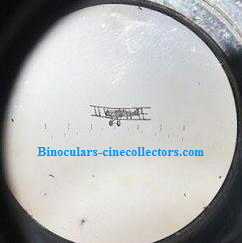 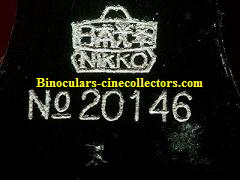
©Copyrights of all pictures Stephen Grose
Stephen Grose described his experience using the device:
“To use the instrument you first adjust the the eyepieces to the correct width to suit your eyes. You then slide the eyepieces along the rail [up and down -note by Anna Vacani] until the aircraft and reticules become clear and focused. When looking through the device you see a line of horizontal reticules plus another set of smaller reticules drawn downwards from the centre point at about 8 and 4 o'clock. The downward angled reticules actually seem to come towards you when viewing in stereo. Twisting the large calibrated knob on the right hand side moves the biplane from behind the reticule marks to over the top of them. When I look through it and place the aircraft's axial over the point where the reticules converge, it reads 20 on the calibrated knob. When I asked a friend to place the aircraft's axial over the convergence point it read 80. He was short sighted so that might explain why our readings were so different.”
The Japanese device design differs from the Carl Zeiss instrument, slightly. The construction of the eyepieces tubes have a different shape and eye width adjustment is mounted in different position:
- in Japanese device by the left ocular;
- in CZJ between eyepieces
 
Japanese device ©Copyrights of the picture Stephen Grose CZJ ocular construction ©Copyrights picture Anna Vacani
The target reticules shown different pictures of the airplane.
|
|